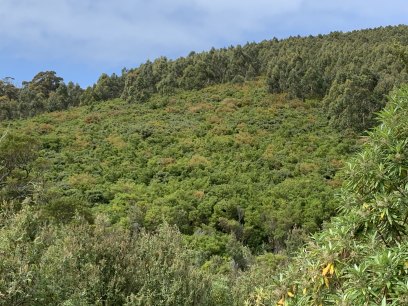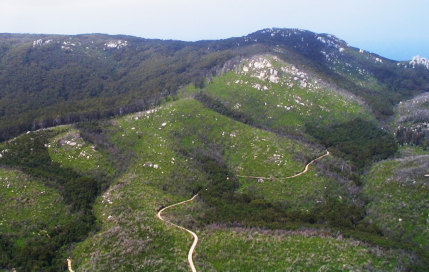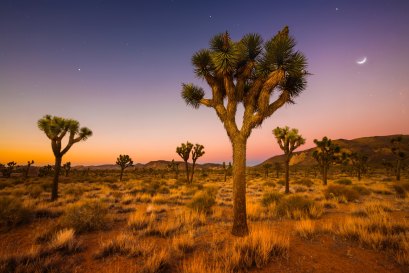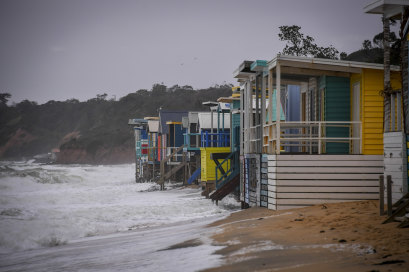
Implementing the changes, her colleague Gregor W. Schuurman told the Times, was brutal.
“It’s bargaining. Nobody wants to do this. We all got in this game, as the Park Service mission says, to ‘conserve unimpaired’,” Schuurman said. “But if you can’t do that in the way you thought, you have to see what you can do.”

A section of collapsed eucalypt forest at the Wilsons Promontory National Park, which Parks Victoria is working to restore.Credit: Parks Victoria
Across Victoria, Parks Victoria is responsible for the care of more than 4 million hectares of landscapes – many in partnership with traditional owners – representing 18 per cent of the state’s landmass.
Norman, who took over as chief scientist eight years ago – “conservation and climate action” was added to his title in 2022– has increasingly become convinced a new approach is needed to help buffer Victoria’s unique landscapes.
In June 2023, he and Parks Victoria’s chief executive Matthew Jackson travelled to the US and Canada to visit sites being hit hard by climate change and learn about the RAD approach – a framework that’s also making inroads as far afield as Finland and South Africa.
In the local version, rangers will look to triage Victoria’s landscapes and locations into areas where resistance can be strengthened; areas where we have to accept that changes are unstoppable (for example coastal inundation, with sea level rises unlikely to retreat); and areas that have already changed.

This section of Wilson’s Prom in the state’s southernmost tip has collapsed forests that Parks Victoria rangers are working to reseed as part of a trial.Credit: Parks Victoria
The challenges facing conservationists and park managers are similar across the globe. The headline events of climate change – changing weather patterns and the increasing frequency and intensity of bushfires, floods and storms – are well-known. But climate change also reveals itself in smaller changes that are less obvious, but equally devastating.
In both Victoria’s forests and the famed Joshua Tree National Park in California, ecological systems are slowly drying out. This has led to trees having reduced defences against pests like bark beetles, and, in some cases, trees failing to produce the seeds required to germinate the next generation.
In Victoria, due to increasingly frequent bushfires, alpine ash – the towering eucalypts found below the treeless plains in the alps – are forming patches of ghost forests, including near Mount Hotham.
Alpine ash, like mountain ash, take about two decades to reach the sexual maturity required to produce seeds to grow the next generation of trees.

Joshua trees in the lower elevations of the iconic national park are dying.Credit: iStock
“Some of our areas have got an average of seven to eight years between the burns now,” Norman said. “So we’re ending up with areas that have nothing but Acacia (wattles) coming through.”
At the Joshua Tree National Park, named for its iconic trees, nothing less than an existential crisis is unfolding. At lower elevations, where temperatures are hotter and rainfall is dwindling, older Joshua trees are dying. Worse, they’re failing to drop seeds to reproduce.
Under the new RAD framework, park officials at Joshua Tree have been forced to accept the trees dying in some sections of the park, managing it as a sort of staged retreat. But at higher elevations, the trees remain strong and healthy. There, they can produce the seeds and young plants needed to protect the species and supply the stock to potentially establish new Joshua Tree forests further north, away from the worst of the heat.
In sections of the park that have suffered severe and atypical wildfires, where Joshua trees have been lost completely, the new blank canvas – while tragic – still offers opportunities for conservation. You could, for example, bring in species that are struggling with even hotter temperatures further south, like endangered cactus species or reptiles from Mexico, says Norman.
“We’re not going to stop sea level coming up anytime soon. So, how do you act differently … what you can for those systems?”
Dr Mark Norman, Parks Victoria
Back home, Norman points out the natural environment also holds important cultural stories, and says this approach is a starting point for conversations with Victoria’s First Nations peoples.
First Nations’ cultural heritage is also under attack from climate change. More frequent floods and more extreme storms have exposed cultural artefacts and ancestral remains along Victorian shorelines, and led to middens containing ancient cultural objects being eroded and exposed.
“We’ve been actively involved in working with traditional owners on sites where storm erosion and high sea levels have been eating into thousands-of-years-old middens and exposing cultural history that really needs protection … It’s essential work to make sure that thousands of years of knowledge and culture is not lost,” Norman said.

Beach boxes exposed to the sea at Mount Martha North in 2018.Credit: Eddie Jim
“There’s understandable upset around Port Phillip Bay beach boxes being washed away by extreme storm events – imagine if that’s the equivalent of your cathedral or your oldest historical building dating back thousands of years. That’s terrible.”
The US National Park Service describes the philosophy behind the RAD framework neatly.
“In short, one can respond to the trajectory of change by resisting (working to maintain or restore based upon historical or acceptable current ecosystem conditions), accepting (allowing an ecosystem to change without intervening), or directing (actively shaping ecosystem change toward preferred new conditions).”
Norman said Parks Victoria would work together with traditional owners to consider the RAD framework and share knowledge about landscapes and ecosystems.
“The core principle of that resist-accept-direct framework is that you have to think about what is really likely to persist here, [and] what is changing beyond our control,” he said.
“We’re not going to stop sea level coming up anytime soon. So how do you act differently to still keep those principles of minimising extinction, minimising loss, maximising native diversity and habitat complexity, and do what you can for those systems?”
Get to the heart of what’s happening with climate change and the environment. Our fortnightly Environment newsletter brings you the news, the issues and the solutions. Sign up here.









 Add Category
Add Category